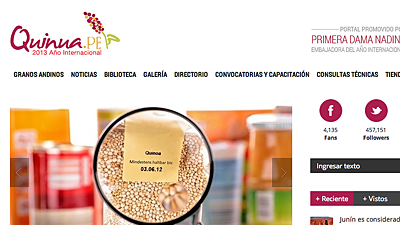Quinoa in the world
The World Bank has joined the celebrations of International Year of Quinoa, promoting its excellent nutritional properties and the plant’s role in improving the lives of Bolivian farmers.
In Peru, in collaboration with the Ministry of Agriculture’s AgroRural Program, the World Bank’s Partnerships Program has financed several projects that include activities to improve quinoa production and marketing in Ayacucho, Apurímac, Huancavelica, Huánuco, Junín and Pasco, the six poorest regions of Peru.
Quinua.pe already has more than 400 free downloads (including books, recipes, videos, photos and research studies). Thanks to support from the Office of the President’s Directorate of Welfare and Social Action and the United Nations Food and Agriculture Organization (FAO) and other members of the Quinoa Multisectoral Commission, the website has had more than 7,400 information downloads and over 26,500 visits so far.
Huaraz farmer Edward Uribe Domínguez, wrote on the website: “I have a 2-hectare field at 3,400 meters above sea level, which has been fallow for over three years. I’m thinking about planting quinoa for export. What I would like to know is: What is the average kilo/hectare yield at that altitude? What type of quinoa do you recommend for export and considering the altitude of the plot? What is the price per kilo of quinoa on the local and foreign markets? What types of processed products are in demand on the global market? Is it necessary to grow organic quinoa for export?”
If you have a question about production or would just like to learn how to make a delicious quinoa-based dish, we invite you to visit quinua.pe and to follow our recipes on our Facebook page, which has been a big hit with homemakers.
“Our audience is varied; we receive visits from everywhere. We have identified three broad publics: farmers, homemakers, and scientists and academics. Technical consultations are usually from specialists and experts in the field,” said Doris Mejía, communications manager of Soluciones Prácticas, which administers the website.
Article by Doris Mejía, Maria Paula Estrada and Giannina Solari of Soluciones Prácticas.

